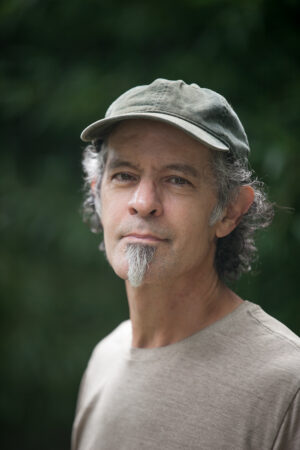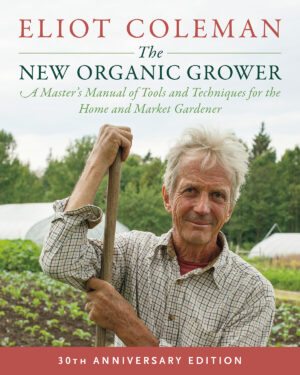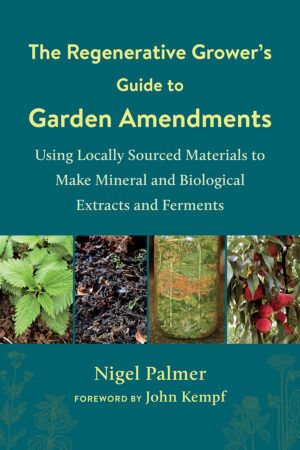Cold-Hardy Fruits and Nuts
50 Easy-to-Grow Plants for the Organic Home Garden or Landscape

EXCERPTS
| Pages: | 384 pages |
| Book Art: | Full-color photographs throughout |
| Size: | 7 x 10 inch |
| Publisher: | Chelsea Green Publishing |
| Pub. Date: | March 4, 2022 |
| ISBN: | 9781645020455 |
Cold-Hardy Fruits and Nuts
50 Easy-to-Grow Plants for the Organic Home Garden or Landscape
*Named one of the best gardening books for 2023 by Gardens Illustrated
*2023 GardenComm Media Awards Silver Laurel Medal of Achievement
The easy-to-use resource for growing healthy, resilient, low-maintenance trees, shrubs, vines, and other fruiting plants from around the world—perfect for farmers, gardeners, and landscapers at every scale.
Illustrated with more than 200 color photographs and covering 50 productive edible crops—from Arctic kiwi to jujube, medlar to heartnut—this is the go-to guide for growers interested in creating diversity in their growing spaces.
“[Levy and Serrano] go way beyond the standard fare. . . . With their help, you’ll be growing persimmons, currants and hazelnuts in no time.”—Modern Farmer
Cold-Hardy Fruits and Nuts is a one-stop compendium of the most productive, edible fruit-and nut-bearing crops that push the boundaries of what can survive winters in cold-temperate growing regions. While most nurseries and guidebooks feature plants that are riddled with pest problems (such as apples and peaches), veteran growers and founders of the Hortus Arboretum and Botanical Gardens, Allyson Levy and Scott Serrano, focus on both common and unfamiliar fruits that have few, if any, pest or disease problems and an overall higher level of resilience.
Inside Cold-Hardy Fruits and Nuts you’ll find:
- Taste profiles for all fifty hardy fruits and nuts, with notes on harvesting and uses
- Plant descriptions and natural histories
- Recommended cultivars, both new and classic
- Propagation methods for increasing plants
- Nut profiles including almonds, chestnuts, walnuts, and pecans
- Fertilization needs and soil/site requirements
- And much more!
With beautiful and instructive color photographs throughout, the book is also full of concise, clearly written botanical and cultural information based on the authors’ years of growing experience. The fifty fruits and nuts featured provide a nice balance of the familiar and the exotic: from almonds and pecans to more unexpected fruits like maypop and Himalayan chocolate berry. Cold-Hardy Fruits and Nuts gives adventurous gardeners all they need to get growing.
Both experienced and novice gardeners who are interested in creating a sustainable landscape with a greater diversity of plant life—while also providing healthy foods—will find this book an invaluable resource.
Awards
- 2023 GardenComm Media Awards Silver Laurel Medal of Achievement
Reviews and Praise
“Outrageous diversity throughout the ecosystem will always be essential for growing healthy fruit and nuts. Allyson Levy and Scott Serrano have provided a thorough guide to adding an intriguing selection of productive plantings to your landscape. Get on board and plant more of everything!”—Michael Phillips, author of The Holistic Orchard and Mycorrhizal Planet
More Reviews and Praise
“At a time when we are rediscovering the value of biodiversity and habitat enrichment, Cold-Hardy Fruits and Nuts offers a compendium of lesser-known backyard forageables that can turn a home garden into a homestead landscape ripe with flavor and nutrition.”—John Forti, author of The Heirloom Gardener; executive director, Bedrock Gardens
“Allyson and Scott are deeply committed plant lovers, and this well-researched, handsome book—with educational photographic portraits of each plant—shares their botanical love affair with us! Hortus Arboretum and Botanical Gardens is their magical plant playground that we get to visit, and this delicious gift is birthed from that rich source. They deftly guide us to diversify our landscape with beauty we can eat, while increasing our personal and ecological health.”—Dina Falconi, author of Foraging and Feasting and Earthly Bodies and Heavenly Hair
“This is the book for growers looking to expand their range of perennial and tree crops. Levy and Serrano have not wasted too much space on general cultivation tips. Instead, they wisely dedicate the bulk of the book to detailed, practical advice on a wide variety of species, some of which I had never come across before, others which I had assumed would need warmer conditions. You will be inspired!”—Ben Raskin, author of The Woodchip Handbook; head of horticulture and agroforestry, the Soil Association
“Allyson Levy and Scott Serrano are consummate gardeners and artists. They bring horticultural prowess and designer insights to this beautiful, easy-to-use, and easy-to-read book. Their in-depth research and hands-on knowledge are invaluable to those looking to expand their palette of plants. Featuring taste profiles, landscape tips, and propagation techniques, Cold-Hardy Fruits and Nuts is my new go-to guide for growing these plants. It is wonderful to see native trees and shrubs included with such enthusiasm and appreciation.”—Marc Wolf, executive director, Mountain Top Arboretum
“This book is filled with enthusiasm for growing uncommon fruits and nuts and I can’t agree more. Allyson and Scott give honest assessments of each plant based on years of hands-on experience. Along with the detailed plant and fruit descriptions, I particularly like their ‘Growth Difficulty Rating’ and ‘Taste Profile and Uses’ sections to help readers decide what to grow. They have me dreaming of growing Himalayan chocolate berries and Korean stone pines.”—Charlie Nardozzi, author of Foodscaping
“Cold-Hardy Fruits and Nuts offers practical experience and useful information on a great diversity of species, including a few surprises. A great place to turn for anyone developing a perennial edible landscape, one of the world’s highest-carbon forms of gardening and farming.”—Eric Toensmeier, coauthor of Edible Forest Gardens, author of Perennial Vegetables
“Allyson Levy and Scott Serrano have been my ‘go-to’ source for information on unusual or common plant subjects to draw. Now they have made their wealth of knowledge available in this beautiful and concise book. Full of essential information alongside interesting facts about each tree, shrub, or vine, the book tells us what to plant and why, how to best grow it, when to harvest, how to crack the nuts, and what to do with an abundance of fruit to preserve. The photos are lovely and descriptive. As an artist, a harvester, and a novice gardener, I now have all the information I need about my fruit and nut growing in one book!”—Wendy Hollender, botanical artist and author of The Joy of Botanical Drawing
“Cold-Hardy Fruits and Nuts covers a full range of edible plants for the home landscape—from the familiar to the lesser known to the truly exotic. Highly recommended for its great level of detail. The authors’ deep research into botanical history and descriptions both satisfies my curiosity and makes me want to delve even deeper into the information they provide.”—Robert Kourik, author of Sustainable Food Gardens and Designing and Maintaining Your Edible Landscape Naturally
"Beautifully and profusely illustrated, Cold-Hardy Fruits and Nut is impressively and comprehensively informative, exceptionally well written, and thoroughly 'reader friendly' in organization and presentation. Especially and unreservedly recommended for personal, professional, community, and academic library."—Midwest Book Review
"If you are an edible gardener interested in widening the scope of what you grow, or a designer looking to explore where edible perennials meet the ornamental, this book will serve you very well indeed."—Gardens Illustrated
Reviews and Praise
“Outrageous diversity throughout the ecosystem will always be essential for growing healthy fruit and nuts. Allyson Levy and Scott Serrano have provided a thorough guide to adding an intriguing selection of productive plantings to your landscape. Get on board and plant more of everything!”—Michael Phillips, author of The Holistic Orchard and Mycorrhizal Planet
“At a time when we are rediscovering the value of biodiversity and habitat enrichment, Cold-Hardy Fruits and Nuts offers a compendium of lesser-known backyard forageables that can turn a home garden into a homestead landscape ripe with flavor and nutrition.”—John Forti, author of The Heirloom Gardener; executive director, Bedrock Gardens
“Allyson and Scott are deeply committed plant lovers, and this well-researched, handsome book—with educational photographic portraits of each plant—shares their botanical love affair with us! Hortus Arboretum and Botanical Gardens is their magical plant playground that we get to visit, and this delicious gift is birthed from that rich source. They deftly guide us to diversify our landscape with beauty we can eat, while increasing our personal and ecological health.”—Dina Falconi, author of Foraging and Feasting and Earthly Bodies and Heavenly Hair
“This is the book for growers looking to expand their range of perennial and tree crops. Levy and Serrano have not wasted too much space on general cultivation tips. Instead, they wisely dedicate the bulk of the book to detailed, practical advice on a wide variety of species, some of which I had never come across before, others which I had assumed would need warmer conditions. You will be inspired!”—Ben Raskin, author of The Woodchip Handbook; head of horticulture and agroforestry, the Soil Association
“Allyson Levy and Scott Serrano are consummate gardeners and artists. They bring horticultural prowess and designer insights to this beautiful, easy-to-use, and easy-to-read book. Their in-depth research and hands-on knowledge are invaluable to those looking to expand their palette of plants. Featuring taste profiles, landscape tips, and propagation techniques, Cold-Hardy Fruits and Nuts is my new go-to guide for growing these plants. It is wonderful to see native trees and shrubs included with such enthusiasm and appreciation.”—Marc Wolf, executive director, Mountain Top Arboretum
“This book is filled with enthusiasm for growing uncommon fruits and nuts and I can’t agree more. Allyson and Scott give honest assessments of each plant based on years of hands-on experience. Along with the detailed plant and fruit descriptions, I particularly like their ‘Growth Difficulty Rating’ and ‘Taste Profile and Uses’ sections to help readers decide what to grow. They have me dreaming of growing Himalayan chocolate berries and Korean stone pines.”—Charlie Nardozzi, author of Foodscaping
“Cold-Hardy Fruits and Nuts offers practical experience and useful information on a great diversity of species, including a few surprises. A great place to turn for anyone developing a perennial edible landscape, one of the world’s highest-carbon forms of gardening and farming.”—Eric Toensmeier, coauthor of Edible Forest Gardens, author of Perennial Vegetables
“Allyson Levy and Scott Serrano have been my ‘go-to’ source for information on unusual or common plant subjects to draw. Now they have made their wealth of knowledge available in this beautiful and concise book. Full of essential information alongside interesting facts about each tree, shrub, or vine, the book tells us what to plant and why, how to best grow it, when to harvest, how to crack the nuts, and what to do with an abundance of fruit to preserve. The photos are lovely and descriptive. As an artist, a harvester, and a novice gardener, I now have all the information I need about my fruit and nut growing in one book!”—Wendy Hollender, botanical artist and author of The Joy of Botanical Drawing
“Cold-Hardy Fruits and Nuts covers a full range of edible plants for the home landscape—from the familiar to the lesser known to the truly exotic. Highly recommended for its great level of detail. The authors’ deep research into botanical history and descriptions both satisfies my curiosity and makes me want to delve even deeper into the information they provide.”—Robert Kourik, author of Sustainable Food Gardens and Designing and Maintaining Your Edible Landscape Naturally
"Beautifully and profusely illustrated, Cold-Hardy Fruits and Nut is impressively and comprehensively informative, exceptionally well written, and thoroughly 'reader friendly' in organization and presentation. Especially and unreservedly recommended for personal, professional, community, and academic library."—Midwest Book Review
"If you are an edible gardener interested in widening the scope of what you grow, or a designer looking to explore where edible perennials meet the ornamental, this book will serve you very well indeed."—Gardens Illustrated








